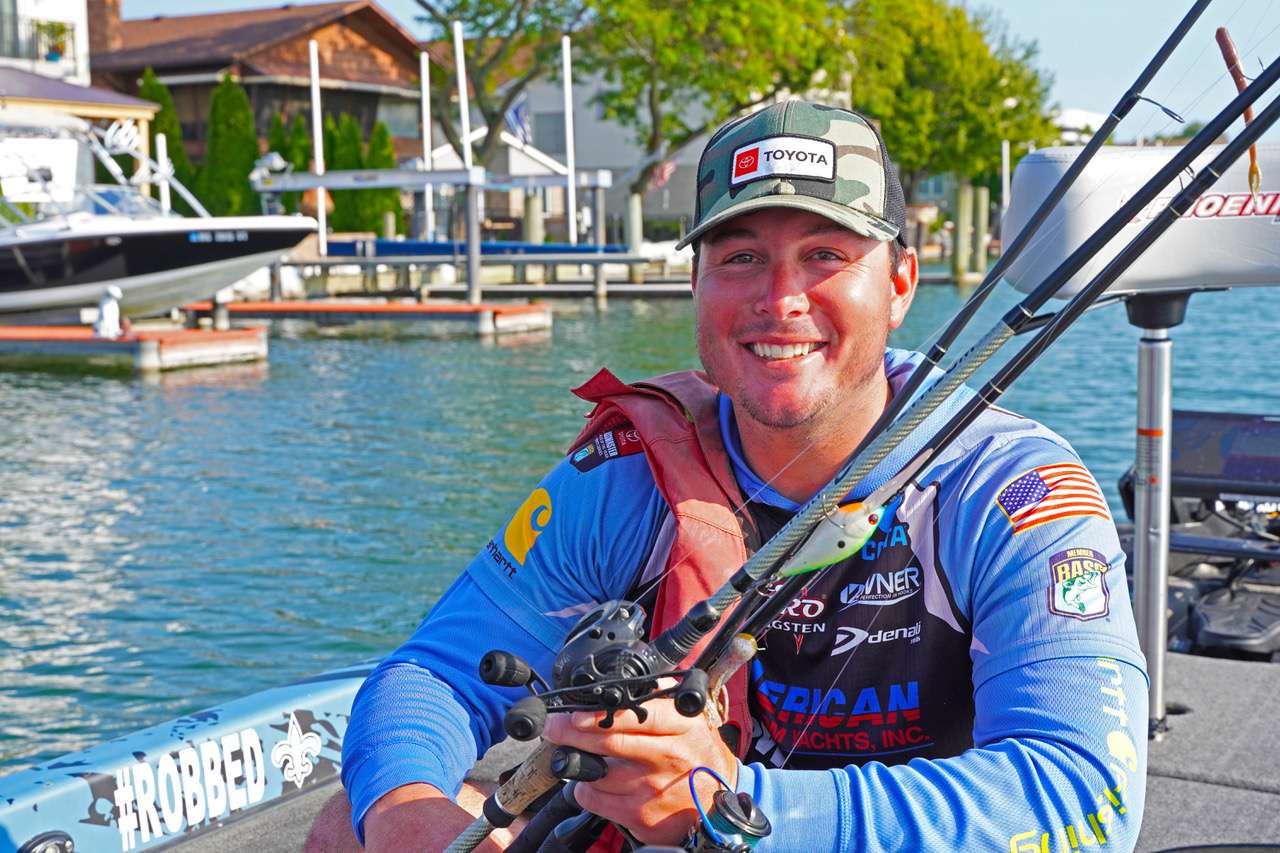
Don’t be fooled by the fact that Bassmaster Elite Series pro Tyler Rivet is smiling on a sunny afternoon in this photo. The day before it was taken, the Southern Louisiana rookie had his finger on the “man overboard” button of his Lowrance units, scared to death his boat might sink 20 miles from the Metro Park ramp on Lake St. Clair.
Rivet was on St. Clair trying to earn his first trip to the Bassmaster Classic when two or three big waves rolled over his back deck and filled his battery compartment with water in seconds. Then, when he hit the manual bilge pump, nothing happened, and within seconds the failed bilge pump allowed at least 4 inches of water to flood the floor of his boat.
“I tried to leave and realized I had so much water weight in the boat that I couldn’t get it on pad,” recalls Rivet, still emotionally shaken by the incident.
He asked his ride along Bassmaster Marshall, who happened to be a pretty big guy, to sit on the front deck, shifting enough weight forward in order to limp 20 miles back to the Bassmaster check-in at Metro Park. Once safely on the trailer, Rivet says water drained from the boat for more than an hour.
Rivet certainly won’t be the only first-timer to take on the big waves of St. Clair in search of world-class smallmouth, so he graciously lends the following advice to help others avoid a rookie catastrophe.
Buy an extra bilge
Obviously, make sure your automatic bilge pumps are working before you head to St. Clair. But make sure you take an extra step and carry an additional portable bilge easily purchased from your local marine dealer. This can’t be stressed enough.
Most experienced big water anglers simply lay the additional bilge on the floor behind their feet at the driver’s console. They run the corrugated pump-out hose over the gunwale on the driver’s side, and zip tie the hose to a cleat to keep it in place. It’s also necessary to add alligator clamps to a few feet of additional wire you’ll want to tie-on to the wires that come rigged on it out of the package. That way you’ll have plenty of wire length to quickly clamp the portable bilge power wires to your battery posts in a time of need, without worrying that it’s a constant drain on your batteries when things are dry.
Don’t go alone
Nobody should fish huge waters like St. Clair alone if possible, and certainly not rookies. Furthermore, adding a companion to the back of deck of your rookie adventure adds false security. The best idea is to take on such waters with another boat of buddies nearby.
“Don’t go to a place like St. Clair alone. Run in packs. Form a small armada. The expansive flats and open water allow you to drift within sight of one another easily without crowding. In practice, Brock Mosley and Luke Palmer and I all sort of raked an area together, it will help you find fish faster, and it’s a whole lot safer than being out there alone,” says Rivet.
What to throw
Preparing your boat for safety is more important than stressing about tackle. Mother nature can be uncertain and cruel, but the fishing on St. Clair is actually relatively simple. Three or four lures will help you catch a huge percentage of the super-sized smallmouth that swim there.
“You need a tube, a jerkbait, a drop shot and a crankbait that will run about 16 feet deep,” says Rivet. “I like a 1/2-ounce weight in my tubes most days, but a 3/4 if it’s super windy. I throw 1/4- and 3/8-ounce weights on my dropshots, and a lot of guys throw a Strike King 6XD or a Rapala DT10, but my favorite is a deep diver from Blackjack Lures,” says Rivet.
“I can’t stress enough how you need to take a little extra time to add a bilge pump, and make sure you’re auto bilge pumps are working. I missed my chance to fish in my first Bassmaster Classic. An extra bilge pump may have saved that chance, but mostly, I just feel so fortunate that I lived to fish another day,” concludes Rivet in deeply grateful fashion.

